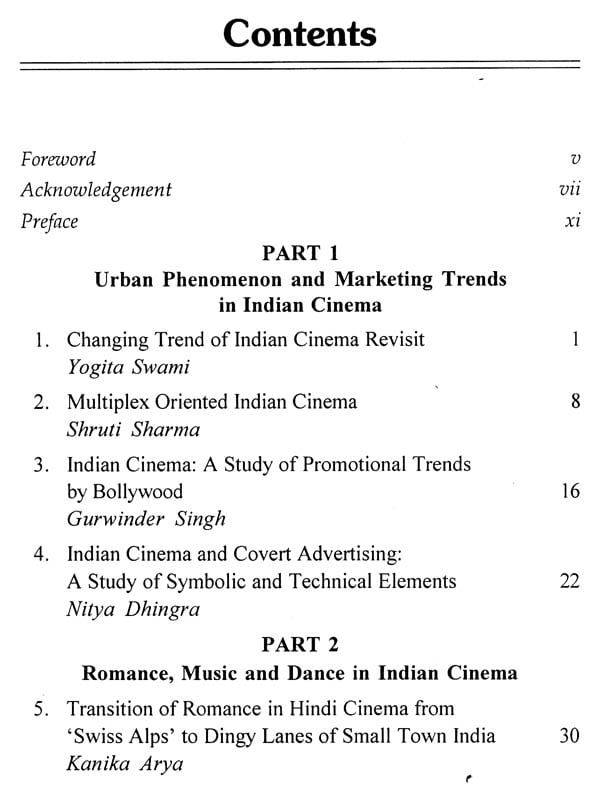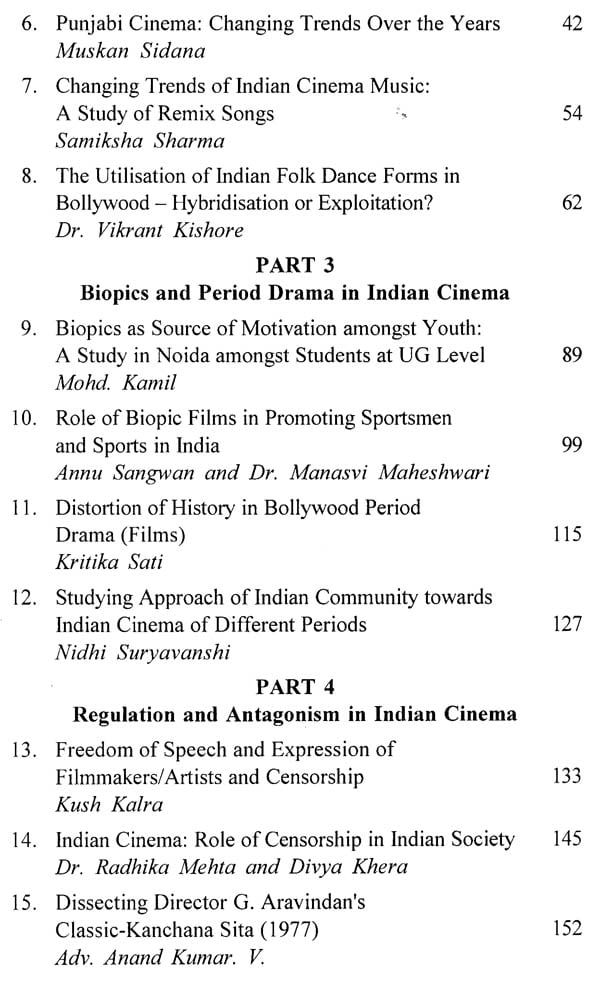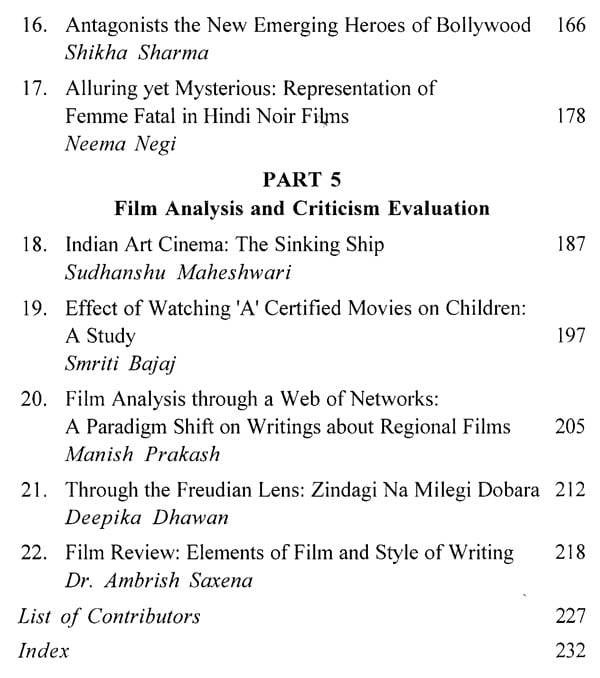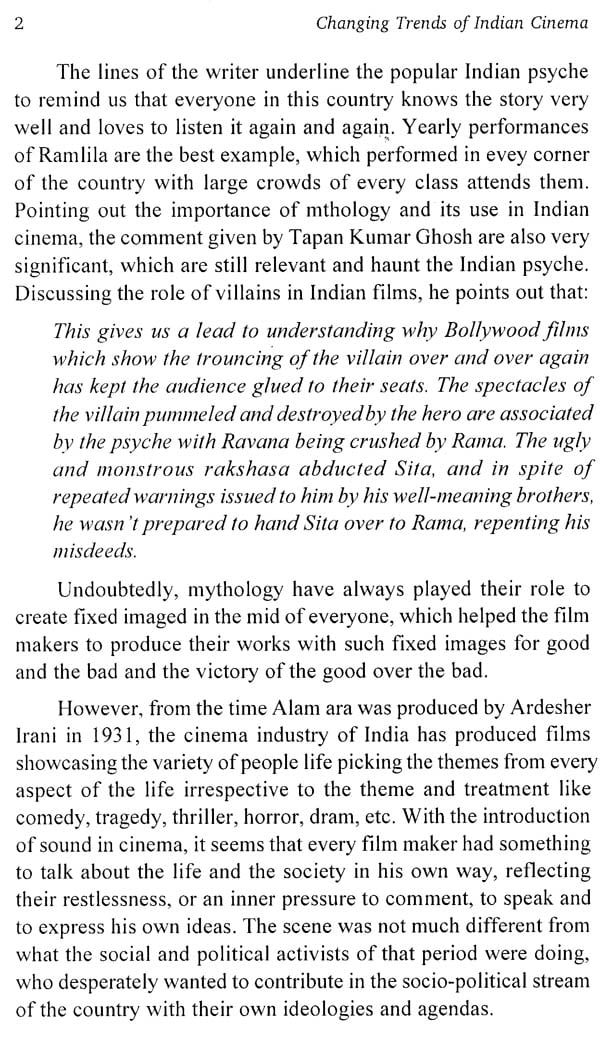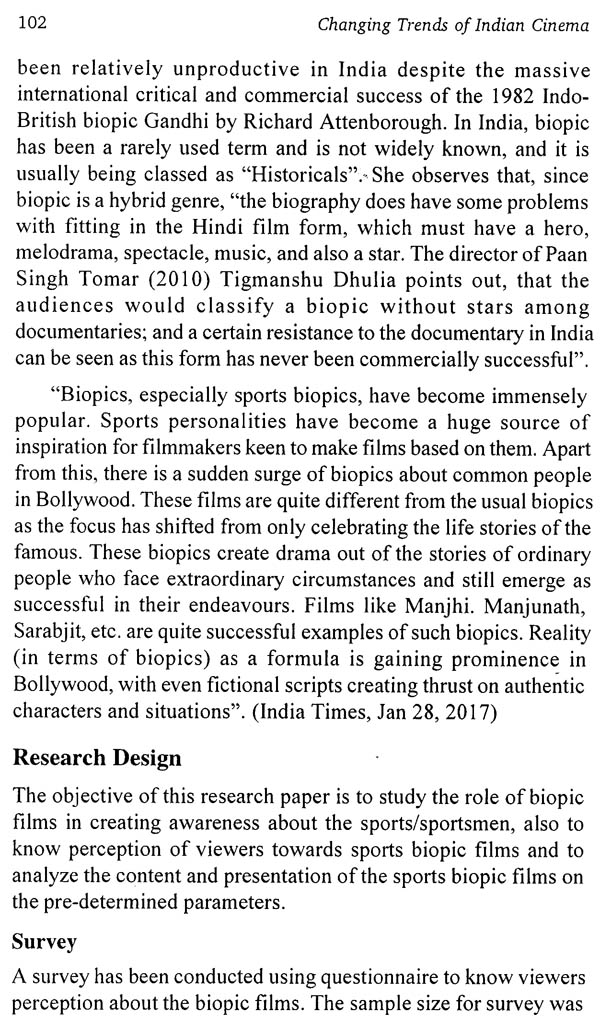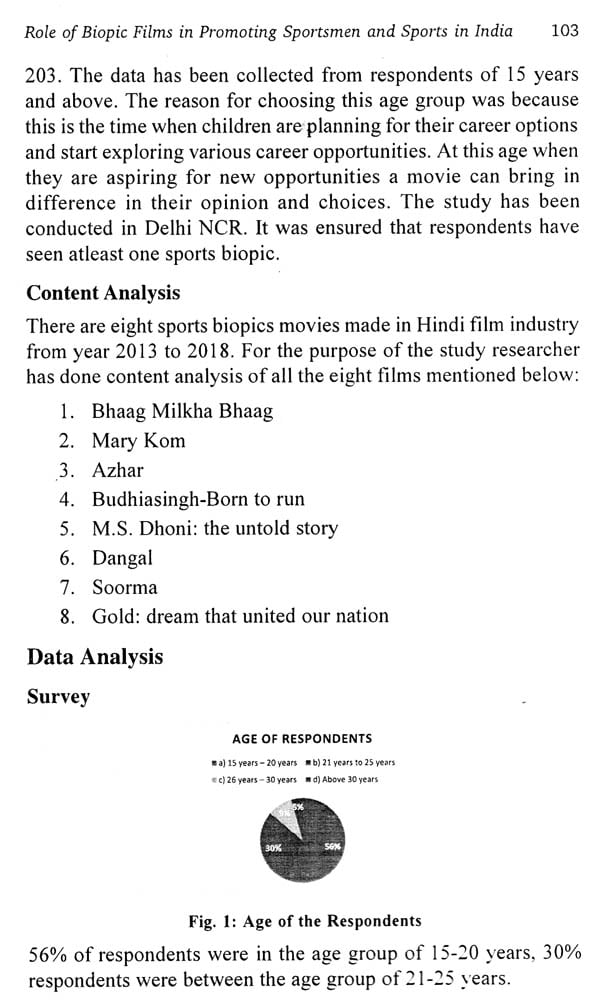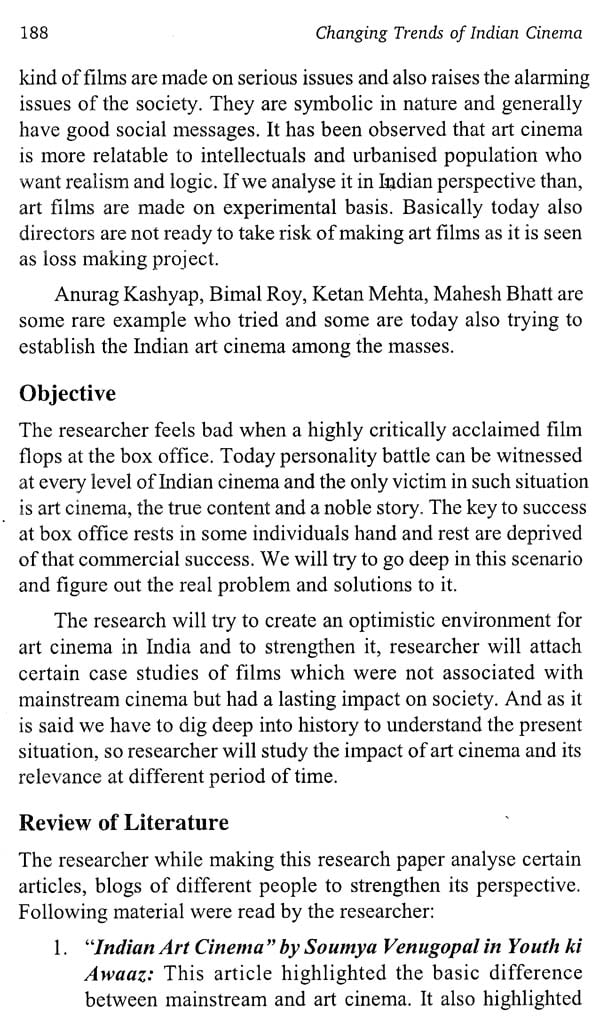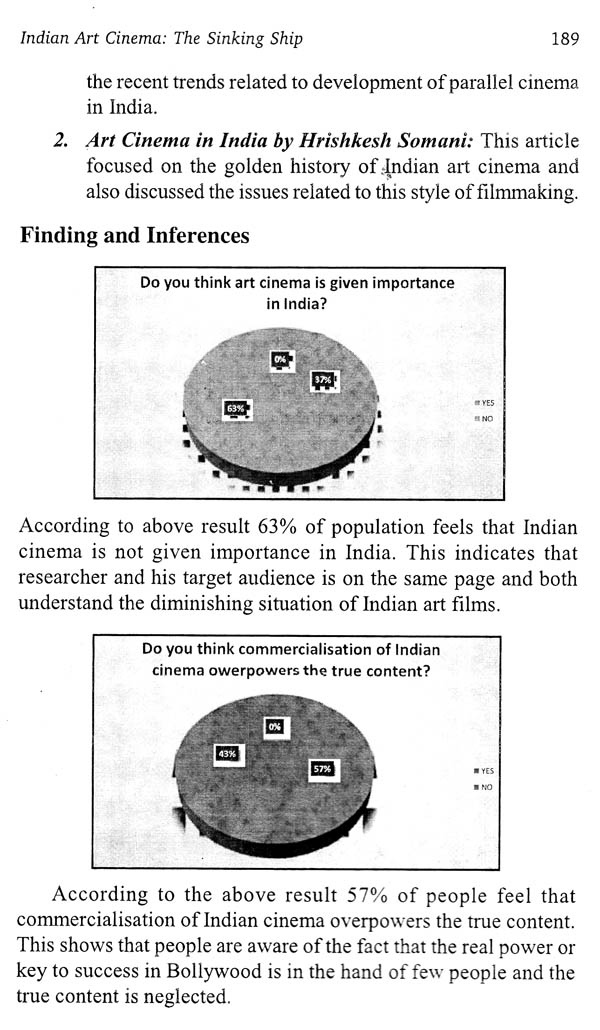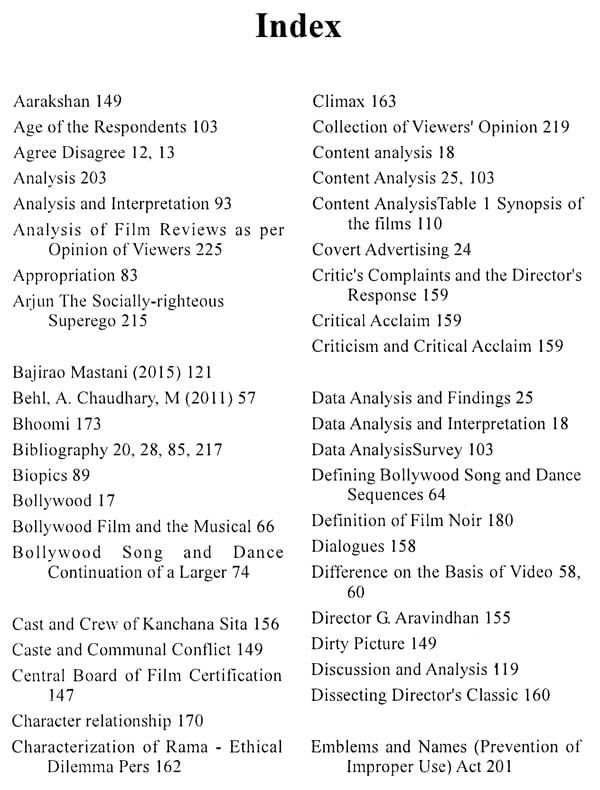
Changing Trends of Indian Cinema
Book Specification
| Item Code: | NAW152 |
| Author: | Susmita Bala |
| Publisher: | KANISHKA PUBLISHERS |
| Language: | English |
| Edition: | 2019 |
| ISBN: | 9788184570755 |
| Pages: | 240 (12 B/W illustrations) |
| Cover: | HARDCOVER |
| Other Details | 8.50 X 5.50 inch |
| Weight | 410 gm |
Book Description
Indian cinema has passed through various phases in the course of its growth for the last one century. The pace of the change has been fast in 21°' century. With increasing urbanisation, the themes and making of films have changed. Multiplexes have made viewing expensive but people do not hesitate in paying. So the producers seem willing to put in more money not only in production but also in promotion of films. At the same time, films are being used for covert advertising. This book talks about many such trends of Indian cinema.
Despite changes contemporary Indian cinema still banks heavily on romance, music and dance. Romance is the lifeline whatever might be the genre of the film. Music and dance is something which is deep into Indian culture. From Hindi films to regional cinema music and dance dominate. Scholars have penned their articles analysing varied strings of music and footsteps of dance.
The trend of biopics is gradually picking up in Indian cinema. Such films are used for motivation of youth and inspire them to excel in specific fields. Many scholars have chosen biopics for their study and their findings form content of this book. Researchers have also studied period drama films while analysing the magnitude of distortion of history.
Further, freedom of expression has always been a contentious issue in films. Scholars always argue the justification and extent of restrictions on cinematic expression. Dissention and antagonism are prevalent in the work of new filmmakers and authors in this book have tried to interpret this phenomena as well.
We witness growing trend of film criticism since viewers these days are found looking for reviews and ratings. Film reviews cover all vital elements of films while attaching significant importance to style of writing.
This book is broadly divided in five segments.
Part 1: Urban Phenomenon and Marketing Trends in Indian Cinema Part 2: Romance, Music and Dance in Indian Cinema
Part 3: Biopics and Period Drama in Indian Cinema
Part 4: Regulation and Antagonism in Indian
Part 5: Film Analysis and Criticism Evaluation
Dr. Susmita Bala is Head of DME Media School at Delhi Metropolitan Education. She is a gifted teacher and trainer equipped with rich experience in media industry and academics for more than three decades. She has taught in colleges of GGS IP University, namely MBICEM and VIPS.
Dr. Susmita has visited Chinese universities as part of delegation of Indian academicians. She has attended a Media Conference and Film Festival in RMIT University, Melbourne, Australia. She has presented papers in Portland and Eugene in the United States as part of pre-conference and the conference organised by International Association of Media and Communication Research (IAMCR). She has presented 20 papers in national-international seminars conferences.
Dr. Susmita has authored 2 books, co- authored 1 book, edited 3 books and written chapters in 3 books. She has been a Member of Jury of Akashvani Awards organized by AIR for many years. She has also been member of Nomination Jury in the International Science Film Festival organised by Department of Science and Technology, Government of India. Dr. Parul Mehra is Associate Professor and Head (second Shift) at Delhi Metropolitan Education with 11 years of academic experience. She holds additional charge of Head, student welfare, DME.
She has recently authored a book on Changing Ethics in India Mediscape which focuses on Indian media, identifies ownership patterns and impact of conglomerates on ethical standards.She has three edited books to her credit. She has published and contributed chapters in several books, apart from research articles in reputed journals. She was an Expert in UGC meeting organized by MHRD in 2015. She is a recipient of DR SATYA JANGHID women achiever award 2018. She actively participates in conferences and seminar nationally.
Pramod Kumar Pandey is Assistant Professor in DME Media School at Delhi Metropolitan Education, Noida. He is also pursuing PhD from GJU, Hisar. He has been associated with the field of media academic for around 7 years which includes 2 years fulltime research experience as UGC-NET JRF. He has participated in many national-international seminars and conferences and has published papers in reputed journals and books.
Cinema and television have long held mainstream entertainment appeal. From a mass media perspective, the content in movies or cinema can be classified vis-a-vis the status of society. There have been those that, upon release, mirror the life and times of the audience. Also present have been both regressive and progressive productions. There are in fact considerable themes into which productions can be categorised and various lenses through which they can be understood.
India produces numerous films in many languages every year. There is also endless hours of television programming churned out, day in and day out. Indian films have been widely recognised as a tool for soft power diplomacy too. Their reach and appeal have transcended borders and left a indelible impression on even India’s fiercest foes. From my travels across South-East Asia I have also seen firsthand how Indian soap operas have a loyal and dedicated audiences well beyond India’s borders. Add to this the heady mix of new networks that have aggregated content and are also producing Indian originals— Netflix, Amazon Prime Video, AltBalaji etc., and the playing field has just expanded exponentially.
Given the scale and reach of Indian cinema and the nuances of the developing TV and networks platform, a study of the journey, direction and impact of these is very much in order. In fact the lack of periodic and systematic analysis of what we are watching, is simply astounding. This series of four books tries to fill this gap, and is a first in what should be a regular inquiry into the state of Indian productions.
These books contain research articles that analyse the various facets and developments in this field, and were presented at DME’s second international ICAN-— Indian Cinema & Alternate Networks Conference. The Conference, partnered by Deak in University, Australia, and inaugurated at the India Habitat Centre on 16th November 2018, received exceptional support and contributions.
It is indeed heartening that we are sharing the spirit of inquiry and awareness with leading academicians of Australia, which is emerging as one of India’s more prominent foreign connection.
An enormous amount of hard work has gone into organising of the conference as well as release of these books, and the ably led DME Media School must be congratulated on this feat.
I am hopeful that these papers contribute positively to the study of an industry that, while understandably acknowledged as a commercial giant, is often intellectually ignored.
Cinema makes a lasting effect on viewers’ mind. It not only entertains but enlightens too. It is the real documentation of the culture, history, heritage and societal issues in a country. Cinema fascinates, it is alluring and captivating, and that is how it draws crowd to theatres all across the globe.
For the creative people cinema is a craft and not an academic subject. Learning the craft may be easy with an ingenious approach and skill friendly attitude. But, academics has its own importance. It gives a depth, an understanding to the producer of cinematic content. Educational institutions perform this job either through prescribing the subject in curriculum or organizing film appreciation workshops.
Besides academic and creative aspect, film making also involves technology and marketing. The arrival of OTT signals the departure of satellite age and internet based promotional tools have changed the dynamics of business. There is an earnest need to appreciate and comprehend these changes in whichever Capacity we are associated with cinema whether as producer of content or merely consuming the content as viewer. ICAN* held on November 16, 17 and 18, 2018, at DME provided a platform for all those who love cinema and want to live with cinema. Technical sessions (8), plenary sessions (3) and workshops (3) during International Conference on Indian Cinema and Alternate Networks delivered ample opportunities to film academia and film makers.
This conference looked at various aspects of Indian cinema while looking into how its reception and consumption, collaboration and distribution have changed over the years. Various aspects of Indian cinema were researched, analysed and discussed by scholars and filmmakers in different sessions of the conference.
ICAN? provided ocean of knowledge in terms of research based writings by eminent and emerging scholars from India and abroad. The research papers presented in this international conference are being published in the form of four books, three in English and one in Hindi. This book Changing Trends of Indian Cinema is one of these books. The other two books are titled "Bollywood Women and Indian Society" and ""World Cinema and Alternate Networks".
This book Changing Trends of Indian Cinema discusses the effect of urbanization on films right from themes to emergence of multiplexes. Some authors talk about the commercial aspects in filmmaking business. Some other authors have focused on the real lifeline of Indian cinema — romance, music and dance in the write ups published in this book.
This book comprises many articles written on biopics and period drama in Indian cinema. While biopics have been interpreted as tools of motivation and promotion, period dramas are accused of distorting history. Freedom of filmmakers and the issue of censorship has also been discussed in some articles.
Film reviews incorporating analysis and criticism is an important component in film studies and many scholars have chosen this subject for writing articles. Many eminent media scholars, researchers and film experts have contributed to this book by penning down the outcome of their research and analysis. Hope, this book will benefit the cine lovers.
**Contents and Sample Pages**
